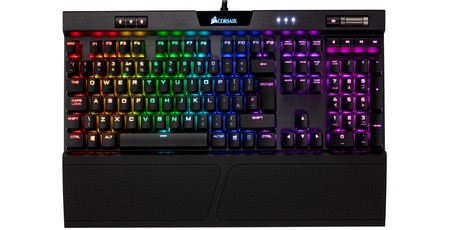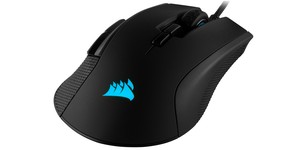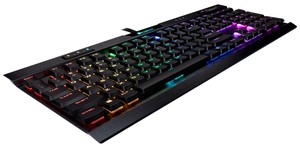
Software
Corsair’s software package iCUE acts as a merger of the original Corsair Utility Engine (CUE) and Corsair Link and will be the main hub for everything Corsair going forward. Given how much customisation can be done on one product, let alone an entire catalogue, it’s a pretty deep software package, and it’s changed since we last saw it. To help support and entice users. Corsair has produced a series of 12 short instructional videos.

There are four main tabs: the Home screen where you select your cross-device profile and delve into individual devices, the Dashboard where you can display a variety of system information, the Instant Lighting tab that sets all devices to a single colour and overrides all custom settings until it’s disabled, and the Settings tab where you can configure global device and iCUE settings.
The K70 RGB MK.2 supports both software and hardware profiles, giving you the best of both worlds: With software-managed profiles, you get maximum customisation, while hardware ones will work and execute custom commands even when plugged into PCs without the iCUE software. There’s also no need to log in or create an online user account a la Razer Synapse. Individual profiles can be assigned to specific apps/games, and you even give iCUE custom backgrounds as a reminder of what the profile is (as well as rename it, of course). Import and export functionality means users can share and back up their settings too.
Selecting the K70 RGB MK.2 from the Home tab, you are presented with three sub-menus for whichever profile you also have active; note that hitting the profile switch button will cycle between either software or hardware profiles depending on what you are presently using, which seems sensible.

Actions is where custom functions are managed. There’s a wide variety of options presented in a drop-down menu whenever you add a new action, although the list is understandably shortened when working in a hardware profile. Macro recording is suitably advanced, permitting all mouse and keyboard actions, different playback options, and even lighting/sound triggers on activation. There’s no delay when assigning actions to keys, and the both the list and keymap make it clear which keys are available and not. The only thing that’s arguably “missing” is a secondary layer whereby a Shift or FN key adds a second customisable function.

The self-explanatory Lighting menu again has heaps of different effects including predefined and fully custom ones. Software profiles can stack effect upon effect, while hardware ones can have either one predefined pattern or up to five Custom ones. Once you’ve added an effect, you can customise various elements of it like colour, speed, duration, etc. and then simply select the keys on the map that you want it to apply to. Everything again applies instantly, so it’s easy to see what you’re doing in real time. The Lighting Link settings keep lighting effects synchronised across the devices for which that effect is chosen, and one of the options is temperature, meaning you could quite easily have your entire system (with relevant Corsair hardware) glow red or orange when it heats up.

Lastly, the Performance menu gives you RGB colour control for the three indicator buttons along the top row and lets you set what the Windows Lock does.

Conclusion
The K70 RGB MK.2 is a keyboard to be reckoned with. It excels on both the hardware and software fronts, and I’m especially happy with Corsair’s progress regarding the latter; iCUE is both immensely powerful and intuitive, which is a delicate balance to get right. The pricing is high, but it is in line with other premium mechanical RGB keyboards, and the Cherry MX switch types offered are likely to keep most gamers happy. Combining the best of Corsair’s keyboard engineering from the past few years, the K70 MK.2 asserts itself clearly as one of the very best keyboards on the market.


MSI MPG Velox 100R Chassis Review
October 14 2021 | 15:04








Want to comment? Please log in.